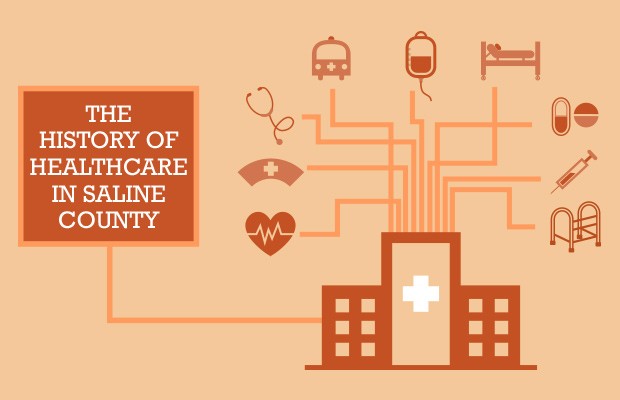The History Of Healthcare In Saline County

When the place we call Arkansas was purchased from the French in 1803 there were very few humans in the region. In the following twenty years those who migrated to the wilds of Arkansas were small in number because of the almost impenetrable swamps of the Mississippi Delta. Most of the immigrants traveled the Southwest Trail (Old Military Road). Everywhere the trail crossed a major stream someone set up a ferry. In addition to the ferry there was often a small store for supplies, a post office, a room for the night and a saloon. These ferry crossings became the nidus for towns along the trail. Saline Crossing at the end of River Street in Benton was one of those places.
The majority of the first immigrants were poor young families looking for a piece of good land that was unclaimed. Often, the men came alone, cleared a plot of land, built a house and then sent for their family. As to what these adventurous souls faced, it was clearly a hard life. Basic food stuffs like flour and salt were only intermittently available. The principal meat sources were pork and wild game. Taking a page from the American Indians, homegrown corn, beans and squash became staples in the diet.
Illness and disease were a fact of life. The germ theory of disease had not been formulated and the prevailing belief was that each location had an epidemic constitution; for each locale there was a set of temperature, wind, humidity and decaying organic material in the environment that created an epidemic of disease; as long as this combination existed the epidemic would continue. The word malaria derives from the Latin for mal (bad) air. The most important of the illness they faced were the “Fevers” (malaria and typhoid). Almost everyone who came to the wildness had a version of these illnesses in their first year; if they survived, they were said to be “seasoned.” The heaviest burden of illness fell on the young mothers and their children. Maternal and infant mortality were high and would continue to be so until the mid-20th century.
Three violent illnesses dominated the wilds of Arkansas throughout the 19th century: smallpox, cholera and yellow fever. Despite the fact that there was an adequate vaccination for smallpox, the average citizen was almost as afraid of the immunization as they were the disease. It would not be until 1917 when the newly formed Arkansas Board of Health mandated smallpox immunization for school attendance that smallpox began to be controlled. Cholera was introduced into the United States in 1832 and for the rest of the 19th century especially during the Civil War it was an ever-present danger. Yellow fever, though not widespread or prevalent in the hills of Saline County, was feared much like Ebola. The hint of yellow fever caused people to abandon their towns or set up “shot-gun” quarantines preventing strangers from entering.
As for health care, most people were on their own. Medical self-help books like Dr. Gunn’s Domestic Companion were in common use. Generally, where two or more people gathered someone calling themselves a doctor was around; most were poorly trained. A typical doctor’s bag of that day contained: medicines to induce vomiting or diarrhea, dental gear to pull teeth, canvas bandages, a variety of non-sterile surgical blades, splinting material and cupping glasses for blistering. He was also equipped with a number of tonics, oils, chest rubs, and expectorants that he compounded on the spot.
The second half of the 19th century saw the emergence of the germ theory of disease and the development of vaccines and anti-toxins for many of the common diseases that plagued the people of Saline County.
Hookworm was a common infestation across the southern U.S. causing a wasting illness and anemia. On average, one in five people Arkansas had hookworm in their stools. In Hot Spring, Grant and Saline Counties four of five people had the ubiquitous nematode. The prevention was simple: wear shoes and have a contained privy. The difficulty was: in rural districts of the state only 47 percent had ordinary outdoor toilets, 53% had no facilities at all.
The Spanish Flu of 1918 killed over 7000 people in the State of Arkansas in a matter of months compared to the 2200 soldiers killed in WWI; there was no treatment or prevention except for isolation and quarantine.
Pneumonia was the most common cause of death, followed closely by tuberculosis. Infant diarrhea and high infant mortality was still a major cause of death especially among the poor. As life expectancy improved the diseases of aging began to raise their collective heads; heart disease, diabetes, stroke, kidney disease and cancer were all now showing up on the radar screen.
If we peered into the doctor’s bag in the 1920s, what would we have seen? The paraphernalia used for bleeding and cupping had been discarded. There was a ready supply of clean bandages and plaster material and a modern stethoscope for listening to the chest. He had an array of surgical blades and steel instruments that gave the appearance of cleanliness. From a medicine standpoint he had all of the standard chest rubs, nose drops, cough medicines and ointments that he compounded on the spot. By 1922, insulin for diabetes was introduced.
As the 20th century progressed new medicines and technologies changed the face of medicine. Sulfa in the mid-thirties and penicillin in the mid-forties opened the door to significant changes in the treatment of a number of ancient infectious diseases. Advances in radiology and electrocardiography in the 1920s and 1930s helped to improve the diagnostic acumen of even the lowly country doctor.
The mid-20th century was dominated by Polio: a viral disease that struck primarily children, leaving many of them paralyzed for life. Saline County was not spared this dreadful problem. Interestingly, this with was the first time that the federal government, state public health, private medicine and the drug industry combined their efforts and within ten years polio was a disease of the past in the United States.
The first hospital in Saline County was the Bauxite hospital created in 1911 to serve the workers and families of the aluminum industry. In the 1930s and 1940s several physicians in Benton created small hospitals associated with their offices.
On June the 23rd, 1955 Saline Memorial Hospital was opened. It had forty-three beds and consisted of obstetrics and nursery, surgery, and two small patient wings. Soon there was an influx of specialty physicians: first came general surgeons, followed by radiologists, orthopedists, obstetrician /gynecologists and a variety of sub-specialists.
The last forty years have seen the emergence of practical smoking cessation initiatives, cardiovascular screening and hypertensive treatment, diabetic intervention, pap smears, mammograms, colonoscopy and prostate screening; each of these, when used, results in a dramatic reduction in death from chronic disease.
So where are we going from here? As suburban sprawl engulfs us will our patterns of health and disease become that of the greater central Arkansas community? Will a whole new series of disease and health problems demand our attention? Those questions are left for someone in the future to answer.









0 comments